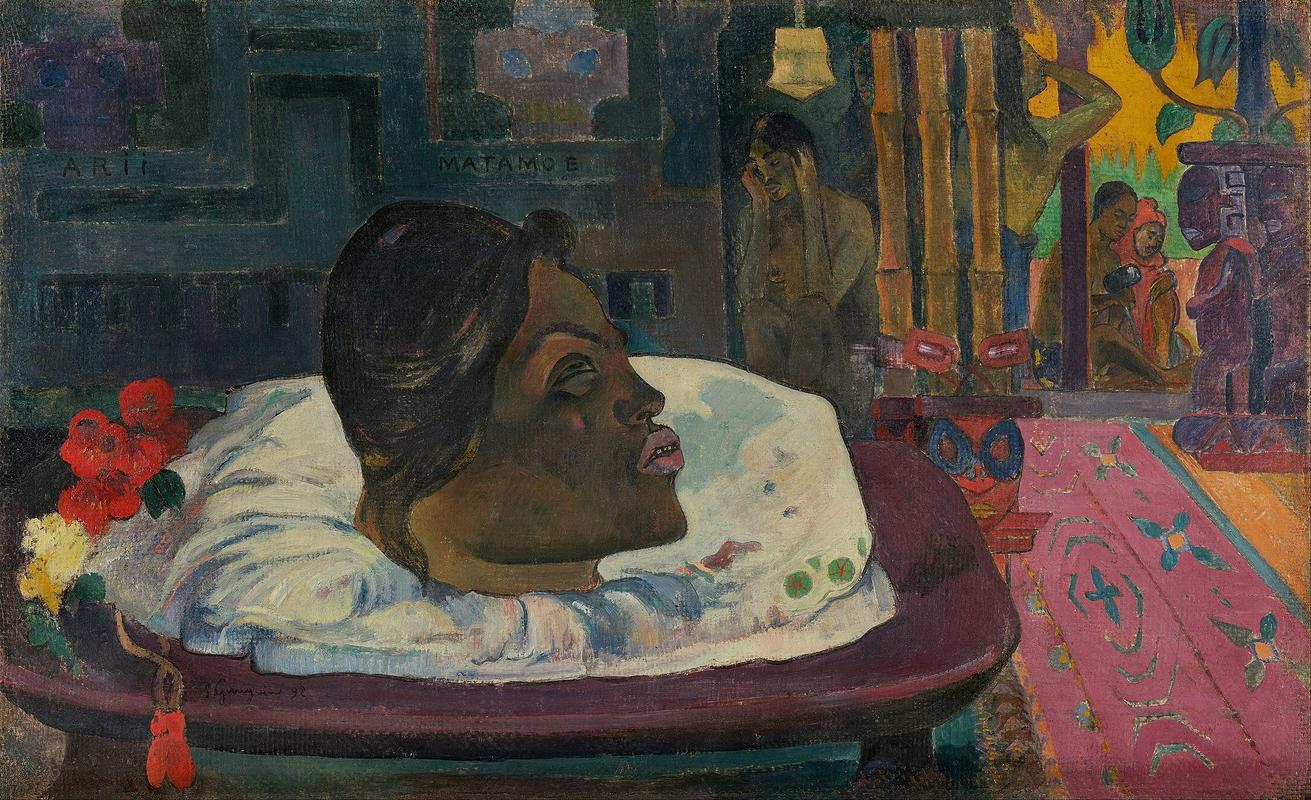More about The Royal End

Contributor
Paul Gauguin was on his first solo trip to Tahiti when he painted Arii Matamoe.
Now, such a ritual, as depicted in the painting, doesn’t exactly exist. The French painter was highly imaginative and took various liberties while portraying his exotic subjects. So, think of it as a mix and match of super-early ethnographic ideas. You know what that means. Racism. The art world is still pretty confused about the guy. I mean, with the wife-beating and the syphilis epidemic he started, Gauguin isn’t making it easy for us.
In 1890, Gauguin’s wife kicks him out of the house. Yeah, Matte Gadde, you go girl! Two years later, the French artist is in Tahiti, finishing some of his most famous paintings. Gauguin’s timing was incredible, King Povare the V, had just died of alcoholism and funeral processions were underway. Gauguin hoped that his fascination for both the macabre and the antiquity of life on the island was going to be satisfied. But, island life wasn’t exactly what he’d thought it would be. It was nothing like he’d read. There was no isolation, there was no primitivity. The King’s funeral was carried out by a Protestant priest and had very little to do with French Polynesian culture. Gauguin was really disappointed. The Tahiti that he loved existed a long time ago. Arii Matamoe is said to have been inspired by this event.
But Gauguin was never a one-piece puzzle kind of guy. Arii Matamoe was more than just a monarch’s death. And Gauguin was more than just an ethnographic painter. He believed that “art was either revolution or plagiarism." He believed that once couldn’t simply copy off what they see. It was the artist’s job to fill in the details, to imagine the rest.
We’re not absolutely sure where the severed head comes from, but one theory claims that he may have seen preserved Maori heads. Another theory suggests that the Matamoe was a Maori weapon that had decorations of a head with its eyes closed. The French painter had a thing for beheadings. He had seen one in 1888 and couldn’t really shake the image. Gauguin was a curious guy, and he did his research. In Loti’s book, "Le Marriage de Loti," 'Matamoe' is used to describe one with sleeping eyes or one who is dead.
While Gauguin was in Tahiti, he wrote to his friend, Daniel de Monfried. He said, “I have just finished a severed kanak [Pacific Islander] head, nicely arranged on a white cushion, in a palace of my invention and guarded by women also of my invention.” Now, if a friend wrote to me saying that, I’d definitely think they were crazy. Gauguin was an asshole, and he scammed his way into this trip. But, he’d still be the friend with the most colorful stories.
Arii Matamoe is Gauguin’s most famous painting that had been publicly shown only around 4 times. The buyer didn’t like sharing. They sent away every museum and gallery that wanted to show the work. In 2008, over a century later, the Getty Museum finally acquired the painting from its previous Swiss owners.
Sources
- Pearce, Melissa. “Gauguin's Tahiti: A Creative Obsession.” Culture Trip. The Culture Trip, October 18, 2011. https://theculturetrip.com/pacific/tahiti-french-polynesia/articles/gau….
- Smart, Alastair. “Is It Wrong to Admire Paul Gauguin's Art?” The Telegraph. Telegraph Media Group, September 19, 2010. https://www.telegraph.co.uk/culture/art/8011066/Is-it-wrong-to-admire-P….
- Hill, Amelia. “Gauguin's Erotic Tahiti Idyll Exposed as a Sham.” The Guardian. Guardian News and Media, October 7, 2001. https://www.theguardian.com/world/2001/oct/07/arts.highereducation.
- Wyatt, Edward. “Getty Museum Buys a Seldom-Exhibited Gauguin.” The New York Times. The New York Times, March 12, 2008. https://www.nytimes.com/2008/03/12/arts/design/12gett.html.
- Allan, Scott C. “‘A Pretty Piece of Painting’: Gauguins ‘Arii Matamoe.’” Getty Research Journal4 (2012): 75–90. https://doi.org/10.1086/grj.4.41413133.
- “Art Is Either Plagiarism or Revolution (Gauguin).” Cognitive Edge, December 28, 2006. https://cognitive-edge.com/blog/art-is-either-plagiarism-or-revolution-….
- Brettell, Richard R., and Timothy F. Potts. On Modern Beauty: Three Paintings by Manet, Gauguin, and Cezanne. Los Angeles: The J. Paul Getty Museum, 2019.
- “Arii Matamoe (The Royal End) - Paul Gauguin - Google Arts & Culture.” Google. Google, n.d. https://artsandculture.google.com/asset/arii-matamoe-the-royal-end/tQGY….
Featured Content
Here is what Wikipedia says about Arii Matamoe
Arii Matamoe or The Royal End (French: La Fin royale) is a painting on coarse cloth by the French artist Paul Gauguin, created in 1892 during the painter's first visit to Tahiti. It depicts a man's severed head on a pillow, displayed before mourners, and although it did not depict a common or contemporary Tahitian mourning ritual, may have been inspired by the death of Pōmare V in 1891 shortly after Gauguin's arrival. A curator for the J. Paul Getty Museum suggested Gauguin likely painted the canvas "to shock Parisians" upon his expected return to the city.
Check out the full Wikipedia article about Arii Matamoe












